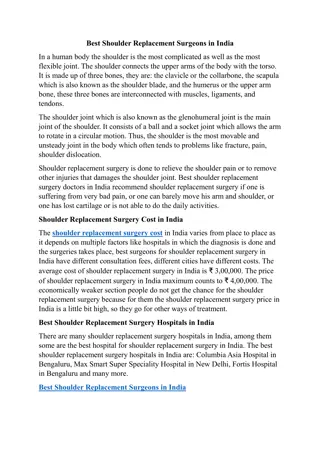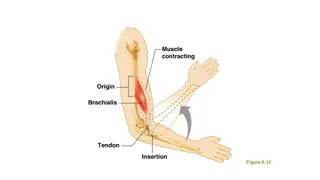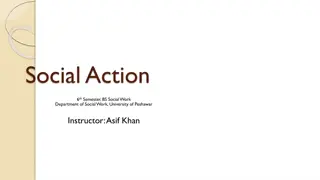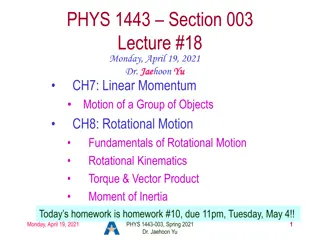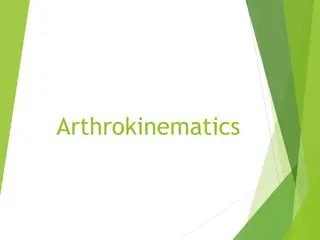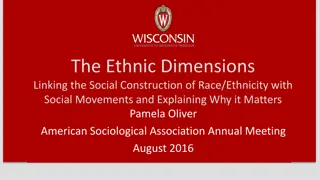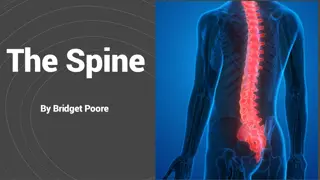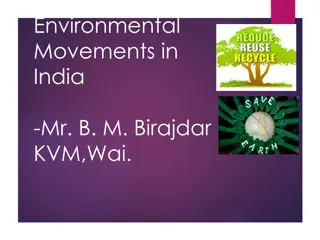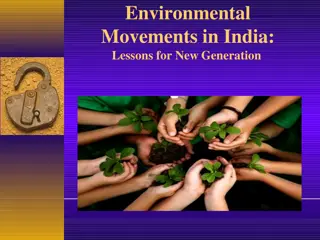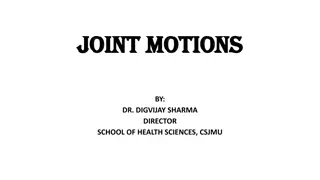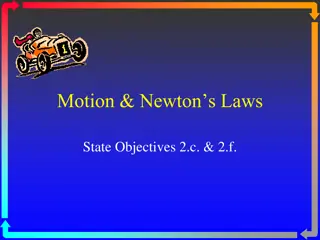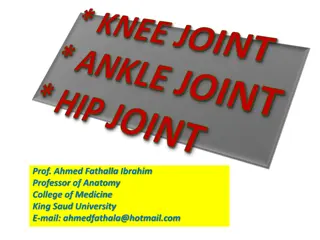Understanding Joint Motion: Osteokinematic and Arthrokinematic Movements
Joint motion involves osteokinematic movements, which are under voluntary control and include flexion, extension, and more. End-feel sensations like bony, capsular, and springy block indicate different joint conditions. Arthrokinematic motion refers to how joint surfaces move during osteokinematic movements. Different joint surface shapes like concave-convex and ovoid joints impact range of motion, with joints like the saddle joint enabling unique movement patterns. Various motion terminologies like joint mobilization and manipulation are applied in therapy. Understanding types of arthrokinematic movements, such as roll, is essential for comprehending joint mechanics.
Download Presentation

Please find below an Image/Link to download the presentation.
The content on the website is provided AS IS for your information and personal use only. It may not be sold, licensed, or shared on other websites without obtaining consent from the author. Download presentation by click this link. If you encounter any issues during the download, it is possible that the publisher has removed the file from their server.
E N D
Presentation Transcript
Osteokinematic Motion-movement done under voluntary control AKA classical physiological motion. Daily we perform osteokinematic movements like flexion and extension We can do these motions in isometric, isotonic or isokinetic exercise.
End Feel-end of joints passive ROM when slight pressure is applied by an examiner. Boney/Hard End Feel- hard and abrupt limit in joint motion.(elbow extension) Capsular End Feel- hard, leather like limitation of motion that has a slight give. (shoulder motions) Empty End Feel- lack of normal mechanical limitation of joint range of motion. (when there is pain or injury) Lets try it!!
Springy Block- rebound movement felt at the end of the ROM.(torn cartilage) Soft tissue Approximation- body segment prevents further ROM( elbow flexion) Muscle Guarding- reflex muscle spasm during motion, it is a protective response seen with acute injuries. Lets try it!!!!
Arthrokinematic Motion- the manner in which adjoining joint surfaces move on each other during osteokinematic joint movement. So osteokinematic motion is referred to as joint motion and arthrokinematic motion is joint surface motion.
Joint surface shapes Joints usually have a concave and convex bone end.
Joint surface shapes Ovoid joint is one that has a concave and convex bone. It has a large Range of Motion (ROM) which allows the joint to be smaller, but these are the more common joint. Saddle Joint is two bones with the same shape moving together. The thumb (CMP) joint is an example
Motion Terminology Joint Mobilization- passive oscillation or sustained stretch applied at a slow speed Manipulation- passive movement applied with a very forceful move in a short range of motion.
Types of arthrokinematic movement: Roll- one joint on another. Like you the ball of your foot across the ground. New points come into contact throughout the motion. Glide/Slide- linear movement of joint parallels to adjoining joint surface. Like an ice skaters blade. Spin- rotation of movable joint surface on fixed surface. Like a top spinning on a table. Lets read page 33 in the text
Concave/ Convex Rule Concave joint surface moves in same direction as body segment motion. Like a finger Convex joint surface moves in the opposite direction as body segment motion. Like the humerus or the femur.
Joint Congruency Each joint has one position that it is congruent, or has the maximum contact with its adjacent joint. In this position they are tightly compressed and difficult to distract. This is the position the ligaments hold the joint most stable. It is also called close pack position
Joint Congruency Incongruent positions are any other position. They are less stable positions and where the joint is most mobile. Also called resting position It is the open packed position. which position would we doing joint mobilization in?
Loose Packed position of the knee is best seen in 25 degrees of flexion. Grab book lets go try it. Pg 35
Extension is open Flexion is closed Which is good, Which is bad???
Accessory Motion Forces-Joint Mobilization Traction- occurs when external pulls the joint apart. Assist in the mobility of a joint traction1
Accessory Motion Forces-Joint Mobilization Compression- external force is exerted on a joint and it is pushed together. Assist in the stability of a joint
Accessory Motion Forces-Joint Mobilization Shear force occurs parallel to the joint and is a gliding motion of the joint. This often occurs with traction to create mobility
Accessory Motion Forces-Joint Mobilization Bending compresses one side and puts traction on the other side. Rotating compresses one side and shears the other. Massage techniques using forces. Lab Packet


